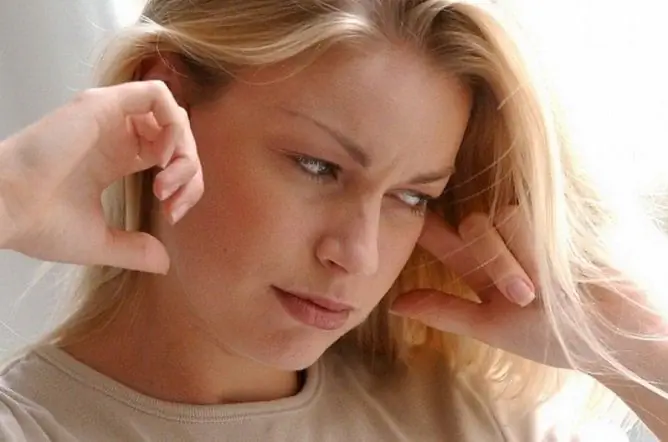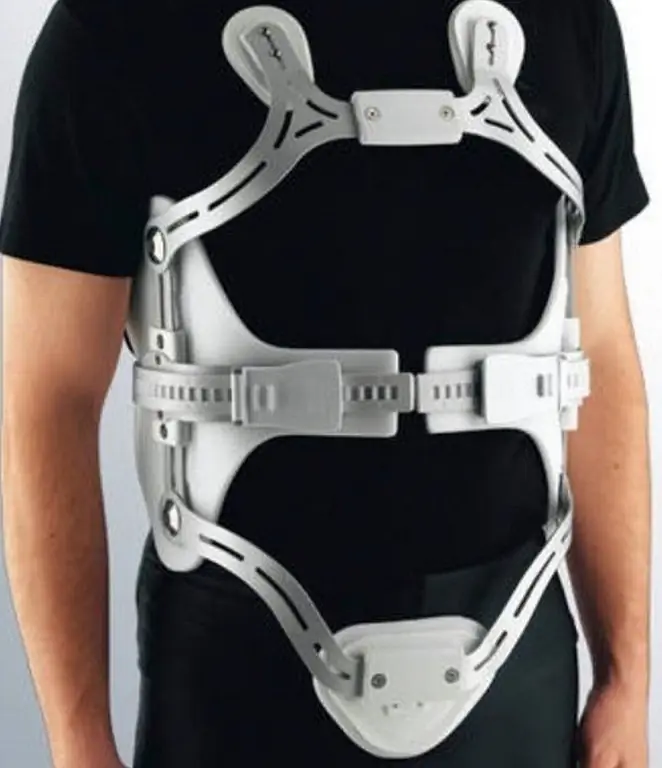- Author Rachel Wainwright [email protected].
- Public 2023-12-15 07:39.
- Last modified 2025-11-02 20:14.
Osteocondritis of the spine
General characteristics of the disease

Osteochondrosis of the spine is a disease caused by the destruction of the bone and cartilaginous tissues of the cervical, thoracic and lumbar spine.
First of all, with the progression of the disease, the central part of the vertebral disc, the so-called nucleus pulposus, is modified. Because of this, the vertebra loses some of its shock-absorbing properties, and thinning and cracks form on the annulus fibrosus along the periphery of the disc.
Further progression of osteochondrosis of the spine leads to complications of the disease - protrusion of discs or ruptures of the annulus fibrosus and intervertebral hernia, as a consequence. Instability of the spine in the affected area leads to pain and limited mobility of the head in osteochondrosis of the cervical spine, as well as to limited mobility of the trunk in osteochondrosis of the thoracic and lumbar spine.
In 75% of cases, it is the osteochondrosis of the spine that is the cause of back pain. With age, the risk of degeneration of the tissues of the spine increases significantly, therefore, on average, symptoms of osteochondrosis of the spine are observed in every second inhabitant of the planet over 30 years old.
Causes of osteochondrosis of the spine
The provoking factors in the development of osteochondrosis of the spine are considered to be back injuries or systematic stress on the back during hard physical work or professional employment in conditions of vibration. If you have to do a lot of loading and unloading work, get a tail lift for your car.
The early manifestation of symptoms of osteochondrosis of the spine is caused by poor physical development, flat feet, or overweight. There is also a genetic predisposition to the loose structure of the intervertebral discs and abnormalities in the structure of the spine. Intensive workouts in the gym in violation of the rules for distributing the load on the back, a sedentary lifestyle and unhealthy diet are also unfavorable in terms of spinal health.
Spinal osteochondrosis symptoms
The disease manifests itself in a number of typical symptoms. Osteochondrosis of the spine is characterized by: aching back pain, a feeling of numbness in the affected spine, a decrease in the range of motion, increased pain when lifting weights, sudden movement, tension when coughing or sneezing.
Chronic pain, as one of the symptoms of spinal osteochondrosis, becomes the cause of increased fatigue. When the nerve roots are squeezed by the discs of the spine, the pain can be more intense and be of a sharp, "shooting" nature. Its localization in this case is not limited to the area of the back, but is felt by a person in the area of the limbs.
Stages of osteochondrosis of the spine
The stage of the disease depends on the severity of the symptoms of osteochondrosis of the spine. At the first stage of osteochondrosis of the spine, pain is practically not felt, if only mild malaise and weak resistance of the spine to injury. The destruction of the annulus fibrosus, a decrease in the size of the spinal clefts and pain of varying intensity are a symptom of the second stage of osteochondrosis of the spine.
The third stage of the disease is characterized by significant deformations of the bone and vertebral tissues up to the appearance of intervertebral hernias. Symptoms of osteochondrosis of the spine of the most severe fourth stage are massive bone growths, limited mobility, intense pain, and complete or partial paralysis of the limbs caused by compression of the nerve roots.
Symptoms of osteochondrosis of the cervical spine

Osteochondrosis of the cervical spine often leads to disturbances in blood circulation due to compression of the arteries. This leads to intense headache, dizziness and fainting. With osteochondrosis of the cervical spine, vertebral artery syndrome is sometimes observed. It is characterized by a sensation of noise in the head, flashing "flies" or colored spots in front of the eyes. With osteochondrosis of the cervical spine, peripheral pain in the shoulder or arm area is also possible.
Symptoms of osteochondrosis of the thoracic spine
Osteochondrosis of the thoracic spine can aggravate the course of various cardiac pathologies. The disease causes the progression of intercostal neuralgia (compression of the intercostal nerves). With osteochondrosis of the thoracic spine, chest pain and a "cola" sensation in the center of the chest are observed.
Symptoms of osteochondrosis of the lumbar spine
Osteochondrosis of the lumbar spine leads to the development of the following diseases: sciatica, lumbago and the so-called lumbar radiculitis.
Sciatica, as one of the complications of osteochondrosis of the lumbar spine, is characterized by damage to the sciatic nerve, pain in the gluteal region, hypotension (decreased tone) of the calf and gluteal muscles.
With lumbago, a symptom of osteochondrosis of the lumbar spine is a sharp pain in the lower back caused by displacement of the vertebrae or prolapse of the spinal disc.
Lumbar sciatica, another complication of osteochondrosis of the lumbar spine, is provoked by hernias of the lowest discs of the spine. It is accompanied by pain in the buttocks radiating to the back of the thigh, popliteal fossa, lower leg and foot.
Diagnosis of osteochondrosis of the spine
The preliminary diagnosis of osteochondrosis of the spine is established by a neurologist after the initial examination due to the patient's complaints of back pain and limited mobility. The stage of osteochondrosis of the spine is ascertained depending on the degree of deformity of the spine, the state of the patient's posture and the number of affected discs.
All of the above symptoms of osteochondrosis of the spine are diagnosed by feeling the patient's back. The doctor also pays attention to the state of muscle tone. Since in most cases the disease is accompanied by hypertonicity of the back muscles.
Spinal flexion tests determine the patient's range of motion. Thanks to the use of radiography, CT and MRI, the diagnosis is concretized and the future tactics of treating osteochondrosis of the spine is determined.
Treatment of osteochondrosis of the spine

In the treatment of spinal osteochondrosis, conservative and surgical techniques are used. The goal of both is to eliminate pain syndrome and prevent further progression of spinal deformity.
At the same time, surgical treatment of osteochondrosis of the spine is used only if conservative therapy of the disease has been ineffective.
The active stage of using conservative methods lasts an average of 2 months. At the beginning of it, a short-term increase in pain syndrome is possible, caused by the body's reaction to medications, physiotherapy exercises (exercise therapy) and physiotherapy. In the conservative treatment of osteochondrosis of the spine, massage, manual therapy, traction and reflexology are also used. The effectiveness of the treatment of osteochondrosis of the spine depends on the systematic nature of the procedures and the patient's persistence in performing the exercise therapy complexes.
Surgical treatment of osteochondrosis of the spine is carried out for herniated intervertebral discs, which are more than 6 months old. The indication for the operation is also a decrease in the gap between the vertebrae to 1/3 of the original size and compression of the roots of the spinal cord.
The leading method in the surgical treatment of spinal osteochondrosis is discectomy, i.e. removal of the deformed disc. The operation can be minimally invasive, performed with the help of endoscopic instrumentation using the microdiscectomy method, B-Twin system, as well as puncture laser vaporization of the deformed disc nucleus.
After surgical treatment of spinal osteochondrosis, a rehabilitation period of 6 months is expected. During it, the patient is sent to a spa treatment for a course of physiotherapy, manual therapy, acupuncture, etc.
YouTube video related to the article:
The information is generalized and provided for informational purposes only. At the first sign of illness, see your doctor. Self-medication is hazardous to health!






